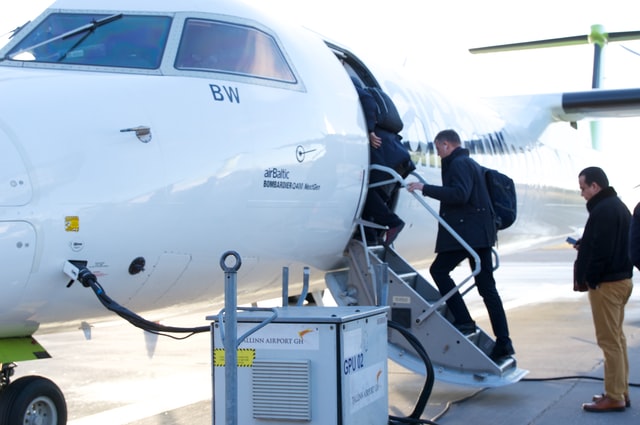If you dream of going around the world and traveling without a return date, but you don’t know how to save the necessary money and make money traveling, this article is for you. Let’s go by parts. Perhaps the first mistake is to think that it is necessary to have a suitcase full of dollars to travel. We live anchored to a collective imagination where travel equals cruise vacations and cocktails on the beach. But in the 10 years since my declaration of nomadism, I have learned that living traveling is cheaper than staying home and that money can be generated while traveling. How? The ways are almost endless, but before I list the main ways to make money traveling, I want to share a little of my philosophy about it.
Above all, I favor economic minimalism, that is, of establishing a healthy relationship with money, generating income as needed and not by income itself. It is not about seeing money as an enemy but as an ally, as a cosmic agent that we make appear when we want.
This also means moving from a passive attitude towards money – waiting for a fixed amount to be credited at the end of the month – to an active attitude: learning to generate it on the spot and in hand. The savings from a permanent job are a good springboard, an initial clean and jerk, but they hardly last if you want to travel for a couple of years or, why not, your whole life. Learning how to earn money traveling is essential to conquering sustainable nomadism.
I started my trip around the world with savings to travel with $ 5 a day for two years. I’ve been traveling for ten years. It was along the way that I learned to make profitable what I like — to write — and that was what started to support me even before my money ran out. In all this time, I came across many other creative people who financed their travels in the most unusual ways. Many times, these ideas appear in the same way. Therefore, it is not necessary to seek in advance to have all the answers. From there comes this list, this catalog of ideas to earn money traveling, or that the trip is your sponsor.

-
Contents
Travel making music
Traveling making music to the cap is the dream of more than one. The good news is that you can! I get many inquiries from musicians who ask me how to save money to travel. I say, but man, traveling with a traveling gift is like having your ATM! Also, I have healthy envy for them. As a writer, if I make handmade books, I have to sell them in Latin America or, if I am worldwide, in English. Still, then not everyone has access to them. Instead, music is universal.
The globetrotting musician’s possibilities go far beyond playing the guitar with the cap in the subway tunnels; it is necessary to dare to think out of the box. I have friends who have made miraculous trips throughout Latin America playing the organ, making chamamé or percussion the Peruvian Cajon. In return, I met a Scotsman who was traveling with his didjeridoo. In Amsterdam, I met an Argentine couple who danced the tango on cruise ships.
The case that moves me the most is that of a close friend, Juan Francisco. Juan went to Europe with his saxophone in tow, not knowing what to expect from fate. Not only did he stay “in the hat,” but he made contacts, met other musicians, and went on tour in Italy with a gypsy-jazz band, with whom he now works every season. He never needed another job again. If you need money, take the sax out of the case. But money is for him just a by-product of music. He says it in his own words: There is no need to speak because a few notes are enough for you to meet this walker with a simple soul who, when traveling, seeks to build that bridge of equality that unites us every one, looking from heart to heart. . “I leave you with a video of Juan, although this time without his sax …
Suppose you are already seriously thinking about it in this blog. In that case, you can find the best places to work with music on public roads in Colombia, Ecuador, and Peru, with advice on where you can and where the police take you out, how people react, etc.
2. Sell food
Everyone has to eat, so offering food is a great way to earn money traveling if you sell food, your potential customer’s number … about 6 billion people! Traveling through South America, I have met many people who prepared their favorite recipe and went out to offer it in the streets, to employees in shops, universities, or outings from concerts, on the beaches, and by pedestrians. Anything goes, the humble pie or homemade bread can become your financier if you do well with the regular and you do not mind talking to people; this can be your resource. In Ecuador, we cross many Argentines offering our specific products. Of course, the main challenge is having a kitchen available. Some motorized travelers have installed them in their combis. I’ve even heard of travelers who hitchhike with churros filler and two 5kg pots of dulce de leche! You have to think that outside of Argentina, these are exotic products that will attract attention. The cons: in Europe, street food sales almost do not exist because everything is super regulated. In Asia, I never saw travelers who resort to this strategy, but if you do, leave us a comment to share with the traveling community…
3. Circuses on the road
Circus, oh circus…. At least once in your life, you have to join a circus. It happened to me in China in 2006, and this will be my example that you can travel by doing a circus. I had met the Cyclone Circus a year ago in Turkey while walking through Cappadocia. Still, then my course was the Middle East, and they were going to Cyprus. The cyclones were nine artists from different countries (USA, Italy, Germany, Canada, and Argentina) who traveled on modified bicycles, armed with two vertically welded frames. They took violins, guitar, accordion, and even a double bass in tow. They improvised jazz and circus numbers in squares, bars, cultural centers, where their pedals carried them.
They traveled for more than 6 years through 27 countries. I briefly joined this beautiful caravan of social exiles in China, hitchhiking to join them as they moved through Southeast Asia. My trip to the Southeast was epic thanks to the sharing, the breakfasts between juggling hats and double bass hits. We ate plates of pad Thai and drank cheap whiskey on the cobblestones of Chang Mai. Once, in Laos, I even saw them join a local circus that traveled by truck through the inland villages. A few times I saw travelers learn as much about the local culture as the Cyclones, an antidote to the current trend of wearing the Argentine shirt and spreading nostalgia for the Milanese.
4. Travel making crafts
Here is the excellent universal wild card to earn money traveling. There are legions of travelers who travel through Latin America selling their handicrafts, producing, and patching. However, they are not seen as much in other continents. Learn to give life to waxed thread, use local materials, missionary seeds, shells from the Ecuadorian coast, Catamarca rhodochrosite, or crocodile fangs from the Amazon. Everything is bought, sold, or collected and becomes a product for sale or a piece of barter. Now, some annotations in the margin. First: the elevation of this resource almost to command means that many people who have other skills (often more highly valued) do not discover them and go like a tube down the path of handicrafts. I swear that in Sucre, I met a couple who went against the current and, despite taking intensive courses, they did not hit the ball with alpaca wire. Naturally, they did not get to sell to exist. They were eating the savings without realizing that the pencil drawings that she made in her spare time would have been something much more original and salable. In some places like Montañita, Máncora, etc., there is an overpopulation of artisans. And only those who already had a lot of experience and new designs did well. So if it’s your passion, don’t hesitate. But if you are a musician, poet, juggler, or painter, you should exploit your talent on that side from what I observed. It must be taken into account that the trade is somewhat stigmatized, so it is necessary not to have the crafts insight when crossing the borders (I saw in person how they owed an artisan 30 days instead of 90 when he entered Bolivia).
5. Make giant bubbles
Someone says the word bubble, and I automatically think of Demian Zen. I name it now, just below the crafts, not to make them run off to imitate Demian, but to show that there are many things besides macramé that can be made. There is no fear to innovate, even if your art or skill is not on this list. Before starting his trip around the world, Demian and I chatted several times. He was afraid of not being able to survive with the bubbles and I, who had already seen him work in front of the Monument to the Flag of Rosario, was sure that his trip and life were assured. But, at first, Demian’sDemian’s confidence was as flimsy as his bubbles. The point is, he cheered up … and he never came back! He recently wrote to me from an International Bubble Festival to which he was invited in India, with full payment, and is emerging as one of the most avant-garde bubblers in Latin America. A story that proves that to be successful, you have to differentiate yourself. I liked his words during a chat we had days ago, and that is why I share them:
6. Draw pictures or portraits
I met many portrait artists who traveled with their lectern and their pastels or watercolors. Taking portraits in the squares is not the only possibility. I’m not a cartoonist, but if I were, I’d try to make handmade postcards of the places I visit and sell them to other tourists. He would keep a catalog of paintings or pictures and offer them to restaurants, bars, and cafes as decoration. A few years ago, we met some boys in Colombia who traveled in a Dodge 1500 to Alaska. In addition to selling T-shirts, they painted advertising signs and murals, something necessary in all countries. In Cartagena, they stayed in a very charming hotel for several days while they finished a mural that they had commissioned.
7. Photography
Today some professional photographers send their material to magazines or sell their works online on platforms to earn money on a trip. An example of this is my Peruvian friend Arturo Bullard. Of course, it takes years to get to play first-class, but fans can also finance their trip with the camera. And in this regard, I want to give you a formula that has fed me for years: artisan postcards.
We sold them for about $ 2 each. We offered to other travelers on the beaches, hostels, and cafes, and locals in the squares of Bolivia, Peru, Colombia, wherever! Since they are inexpensive, anyone who liked your story mildly will buy you one to help you keep traveling. Because, and perhaps the most important thing I say in this article, people are not buying your photo, or your book, or your macramé bracelet; they are feeling empathy and buying YOUR STORY. We never sold less than 10 or 20 a day on the beaches, and many times we exchanged them for menus in the dining rooms. Thus, at one point, we had zero spendings during the trip (hitchhiking, spontaneous accommodation, or couch surfing and redeemed meals)
8. Craft books
It was the first thing I did. In 2000 I published my first handmade poetry booklet and sold it in the bars of Mar del Plata. I did it more out of bohemianism than financial necessity. Still, when in 2005 I grabbed the backpack, in addition to some savings that would soon run out, I took with me the original Harmony of Chaos, one of my artisan books from then (I no longer offer it, To see the current books I followed the instructions in the box below). Then I wrote Vagabundeando on Axis of the Ma before being a printed book; it was also a 100-page handmade booklet. Cons: it is a lot of work to photocopy, assemble the covers, travel with a stapler, etc. You have to have enough conformity with what you do to face people who will often scare you off their tables as if you were offering them stamps. And in many countries, the interest in books is not massive enough to allow you to make a living unless you offer them to other travelers/tourists. That is why in our trip through South America, Laura and I ended up resorting more to artisan postcards, as we explained above.
9. Digital nomad
Working from anywhere in the world using the computer and Wi-Fi as a portable office is a reality for many travelers; When many ask me how to sustain their travels, the first thing I recommend is, if possible, to make their profession portable. Of course, those who have it more accessible are programmers and web designers. More and more companies accept remote workers as permanent employees or freelancers who offer solutions to specific projects. In Bulgaria, I recently met Ramiro, an Argentine who has been moving worldwide for years, as he says, “with more computers than T-shirts in his backpack.” Ramiro is an orthodox WordPress monk who works with clients from all over the world. Without going any further, Laura and I stayed for three weeks at her house in Yablanitza, where she custom-designed our blog templates. Ramiro goes around the world, barefoot, doing Housesitting and doing marketing or SEO consultancies, from Tuscany or Siam Rep. Now he is in Prague, tomorrow who knows. Like many others, it spawns its workspace and swiftly moves through the gaps in the system.
10. Harvest and Woof
Traveling in sync with specific harvest seasons can be an excellent way to stock up on money seasonally. I have met backpackers who have worked on the grape harvest in the Champagne region, France, or – currently in vogue – the kiwi harvest in New Zealand. Of course, in Latin America, salaries in the agriculture sector are pitiful. It is difficult to save money to continue traveling. Another way is to do woofing. WOOF is a worldwide network of organic farms. You become a member by paying an annual fee, and then you exchange work for home and food.
11. Volunteer in hostels
Another classic, not to earn money traveling, but to avoid spending it, is to exchange work in hostels for a roof and food. Hostels around the world need staff who speak English and are familiar with the backpacker lifestyle. Once alone, in Albania, we stayed for two weeks in beautiful Berat, working four hours a day. Hostel work can be very enslaving since it is not the same to be on the other side of the counter, but it can be suitable for when we want to hang a bit in one place and slow down the trip’s pace. Who is entirely using this system is Angie De Rico, who in this post has been in Korea for months and can tell you the honey and the rigor of this option, and how not to give up on anything.
12. I discovered magic….
My colleagues Dino and Aldana, for years, partially finance their trips with magic shows, in the street, in restaurants, hostels, for companies, for birthday parties of people they meet along the way and hire them, etc. Dino (the team wizard) is an example of recycling: tired of his profession as a computer engineer and office life, he decided to transform his hobby and passion into a source of income and travel engine.
13. Various skills: Pandora’sPandora’s Box
The possibilities to earn money traveling are endless.
(14) hairdresser wrote me recently, who went from market to market in Latin America, cutting hair. Several friends have been
(15) movie extras in Indian movies, where they were paid $ 50 per day of shooting. Another friend did (16) television commercials and modeling in Costa Rica. And another
(17) entered the casinos, won at blackjack, and then partied inexpensive restaurants.
Are you
(18) a carpenter? In Germany, there is a medieval tradition, which is still valid, called Wander’s haft in which carpenters or masons went on a trip to practice their profession, being forced to live from it without being able to return within 100 km of their home. In Ankara, Turkey, I met a girl named Bianka, who traveled this way.
On the beaches of Thailand, I met an English woman who gave
(19) yoga classes at inexpensive hotels. He had been living only in summer for years, from the Caribbean to Polynesia, and so on. You can also
(20) teach languages abroad. In Asia, I met a lot of foreigners who taught English in places like China or Malaysia. There was little demand for Spanish teachers, but those who did get a job earned an excellent salary.
Beyond work related to art, there is also the possibility of doing the same work in other countries that we would do at home. Many people work as a waiter, dishwashers, kitchen helpers, painting houses, etc.
Some advice
. What sells is not the physical product you offer. Still, the story, the ability you have to generate empathy and make the other participant in your challenge.
. Re-electing your place in the system makes you an entrepreneur of your art. I mean that whoever sells crafts or postcards – if he knows how to sell – will make five times more money than with a permanent job as a waiter or bartender.
. Sell what you sell, do not wait with your things on a cloth for people to approach you. Choose your clients, get closer, and tell them what and why you are selling it.
. When you get to perfect art and find a way to monetize it that you feel comfortable with, you are virtually free to travel the world indefinitely.
. Do not cheat or plagiarize anyone. It is not necessary. Differentiating yourself is succeeding.
. Do not make your head beforehand; start your trip and give the universe a chance and be attentive to the doors, which sometimes have unsuspected costumes.
. You can also do a bit of all of the above, as some readers told in a Facebook plebiscite:







